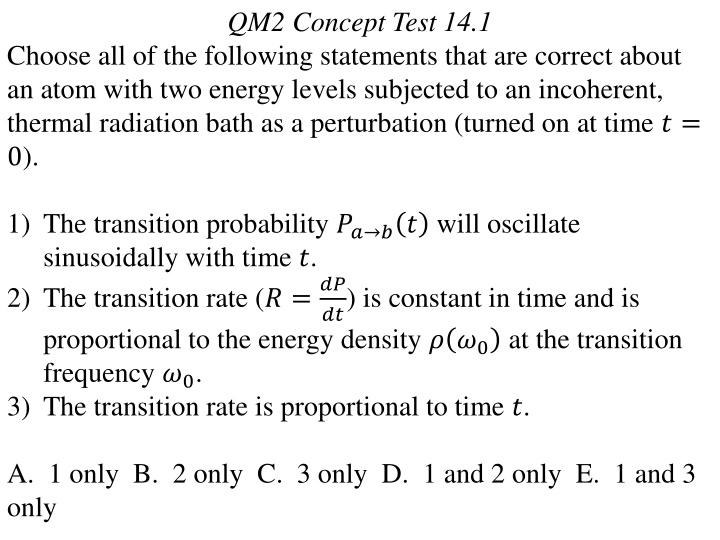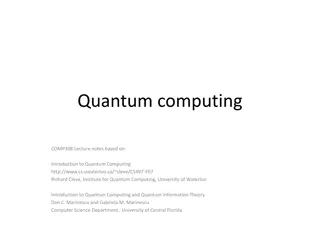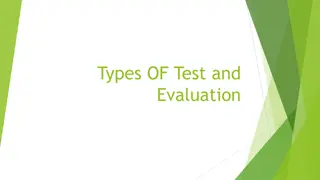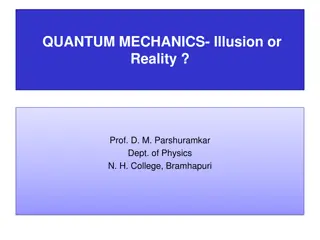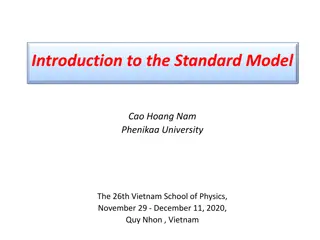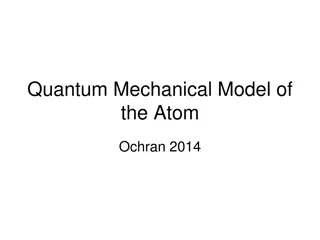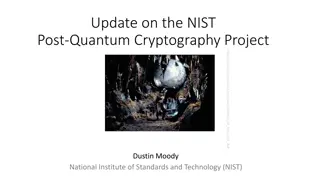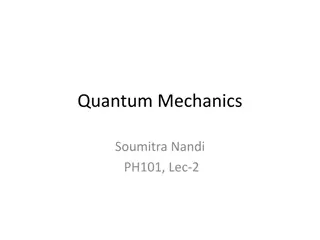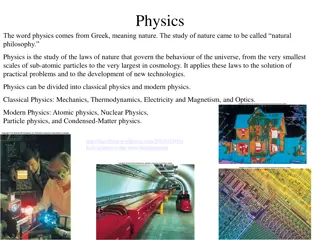Quantum Mechanics Concept Tests 14
Explore quantum mechanics concepts related to atoms, energy levels, perturbations, transition probabilities, and emission rates. Understand the behavior of two-level systems under various perturbations and the dynamics of transitions in hydrogen atoms. Dive into calculations involving transition rates, absorption, emission, and energy densities in different scenarios.
Download Presentation

Please find below an Image/Link to download the presentation.
The content on the website is provided AS IS for your information and personal use only. It may not be sold, licensed, or shared on other websites without obtaining consent from the author.If you encounter any issues during the download, it is possible that the publisher has removed the file from their server.
You are allowed to download the files provided on this website for personal or commercial use, subject to the condition that they are used lawfully. All files are the property of their respective owners.
The content on the website is provided AS IS for your information and personal use only. It may not be sold, licensed, or shared on other websites without obtaining consent from the author.
E N D
Presentation Transcript
QM2 Concept Test 14.1 Choose all of the following statements that are correct about an atom with two energy levels subjected to an incoherent, thermal radiation bath as a perturbation (turned on at time ? = 0). 1) The transition probability ?? ?? will oscillate sinusoidally with time ?. 2) The transition rate (? =?? proportional to the energy density ? ?0 at the transition frequency ?0. 3) The transition rate is proportional to time ?. ??) is constant in time and is A. 1 only B. 2 only C. 3 only D. 1 and 2 only E. 1 and 3 only
QM2 Concept Test 14.2 Choose all of the following statements that are correct about the graphs below. In all cases, ?(?) 1. 1) Graph I may represent the transition probability in a two- level system due to a monochromatic sinusoidal perturbation. 2) Graph II may represent the transition probability in a two- level system due to an incoherent perturbation. 3) Graph III may represent the transition probability in a two- level system due to an incoherent thermal perturbation. A. 1 only B. 2 only C. 3 only D. 1 and 2 only E. 1 and 3 only
QM2 Concept Test 14.3 Choose all of the following statements that are correct when incoherent thermal radiation acts as a perturbation on the hydrogen atom. 1) Between any two stationary states of the hydrogen atom, the rates of absorption and stimulated emission are the same. 2) If the electric dipole matrix element that connects the perturbation to the two unperturbed stationary states is zero, the probability of transition between those states is zero to lowest order in perturbation theory. 3) The same dipole matrix element is involved in determining the rates of absorption, stimulated emission, and spontaneous emission between two unperturbed stationary states. A. 1 only B. 1 and 2 only C. 1 and 3 only D. 2 and 3 only E. All of the above.
QM2 Concept Test 14.4 A two-level system has ?? particles in the lower state with energy ?? and ?? particles in the higher state with energy ??. The spontaneous emission causes ??? particles to leave the upper state per unit time where ? is the spontaneous emission rate per particle. The transition rates per particle for the stimulated emission, ?? ??(?0) and absorption, ?? ??(?0) are both proportional to the energy density of the electromagnetic field ?(?0). Choose all of the following statements that are correct. 1) ???? ??(?0) is the average number of particles transitioning from a state with energy ?? to ?? by absorption per unit time. 2) ???? ??(?0) is the average number of the particles transitioning from a state with energy ?? to ?? by stimulated emission per unit time. 3) ???? ?? ?0 = ???? ??(?0) when the system is in thermal equilibrium. A. 1 only B. 1 and 2 only C. 1 and 3 only D. 2 and 3 only E. All of the above
QM2 Concept Test 14.5 A two-level system has ?? and ?? particles in the lower and higher energy levels, respectively. ? is the spontaneous emission rate. ?? ??(?0) and ?? ??(?0) are the stimulated emission and absorption rates. Which one of the following equations correctly represents the change in the particle number in the upper state per unit time, ??? ??? ??? ??= ??? + ???? ?? ?0 + ???? ??(?0) A. ??? ??= ??? + ???? ?? ?0 + ???? ??(?0) B. ??? ??= ??? ???? ?? ?0 + ???? ??(?0) C. ??? ??= ??? ???? ?? ?0 + ???? ??(?0) D. ??? ??= ??? ???? ?? ?0 ???? ??(?0) E.
QM2 Concept Test 14.6 Choose all of the following statements that are correct about an isolated two-level system with ?? particles on average in the lower energy state and ?? particles on average in the higher energy state at ? = 0 ?. The transition rate for spontaneous emission is ? per particle. 1) ???= ????? 2) The stimulated emission rate at ? = 0 ? is zero. 3) The number of particles remaining in the upper state will decrease exponentially with time. A. 1 only B. 2 only C. 1 and 3 only D. 2 and 3 only E. All of the above.
QM2 Concept Test 14.7 For a two-level system, the lifetime of the upper state with energy ?? is ? = three-level isolated system has ?1 and ?2 as the spontaneous emission rates per particle to the two lower states from the uppermost state with ?? particles at ? = 0 ?. Choose all of the following statements that are correct. 1 ?, where ? is the spontaneous emission rate per particle. Suppose a 1) ???= ?1??1?? ?2??2?? where ??1 and ??2 are the number of particles in the two lower states at a given time ?. 2) The number of particles in the uppermost state will decrease exponentially in time. 3) The lifetime of the uppermost state of this three-level system is ? = 1 ?1+?2. A. 1 only B. 3 only C. 1 and 2 only C. 1 and 3 only E. 2 and 3 only
